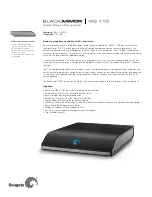
network. Additionally, your devices collect and store the user name and other important
information for each application. These profiling activities provide you with an inventory
of operating-system and software applications, versions, and the components that use
them.
You can use this information to proactively update your network or respond quickly to
vulnerability announcements.
Proactively Updating Your Network
To eliminate security holes, you should update your software applications regularly.
Some guidelines:
•
Research known vulnerabilities
. Compare the information in the Profiler with a software
vulnerability database, such as Security Focus at
http://www.securityfocus.com/bid
or
Common Vulnerabilities and Exposures (CVE) at
http://www.cve.mitre.org/cve/
.
•
Plan to patch
. After you identify your vulnerable systems, schedule a regular
maintenance time to keep downtime and disruption to a minimum.
Even if your network components do not require security patches or updates, they might
use default configurations. Many network device vendors use a common phrase, the
vendor name, or other simple word as the default password for accessing the
administration interface of their device. Because these passwords can be guessed easily,
the vendor recommends that users change the default password immediately. However,
for convenience, some users leave the default configuration password, unknowingly
opening a security hole in the network. The Profiler captures user information that you
can use to see who is logging in to network devices so you can verify that they are from
trusted IP addresses.
Reacting to Vulnerability Announcements
New network attacks and exploits are discovered every day. When new security patches
are issued, use the Profiler to quickly identify which systems are running the affected
software version, then patch them appropriately.
For large networks, it is difficult to patch everything immediately. Plan your patching
process by prioritizing based on the importance of the resources. Critical, high-risk, and
heavily used resources should be patched first, while less important, minimally used
resources might be able to wait.
Example: Identifying Vulnerable Components
For example, Microsoft announces a vulnerability in version 6.0 of the Microsoft Internet
Informations Services (IIS). To quickly identify all network components running the
vulnerable version:
1.
Select the
Protocol Profiler
to see the applications running on the network.
2.
In the Context Filter data table, select
HTTP Header Servers
. The value data table
lists all Web servers currently running. The network uses the following Web servers:
Copyright © 2010, Juniper Networks, Inc.
718
Network and Security Manager Administration Guide
Summary of Contents for NETWORK AND SECURITY MANAGER 2010.3
Page 6: ...Copyright 2010 Juniper Networks Inc vi...
Page 36: ...Copyright 2010 Juniper Networks Inc xxxvi Network and Security Manager Administration Guide...
Page 52: ...Copyright 2010 Juniper Networks Inc 2 Network and Security Manager Administration Guide...
Page 90: ...Copyright 2010 Juniper Networks Inc 40 Network and Security Manager Administration Guide...
Page 144: ...Copyright 2010 Juniper Networks Inc 94 Network and Security Manager Administration Guide...
Page 146: ...Copyright 2010 Juniper Networks Inc 96 Network and Security Manager Administration Guide...
Page 234: ...Copyright 2010 Juniper Networks Inc 184 Network and Security Manager Administration Guide...
Page 310: ...Copyright 2010 Juniper Networks Inc 260 Network and Security Manager Administration Guide...
Page 364: ...Copyright 2010 Juniper Networks Inc 314 Network and Security Manager Administration Guide...
Page 366: ...Copyright 2010 Juniper Networks Inc 316 Network and Security Manager Administration Guide...
Page 478: ...Copyright 2010 Juniper Networks Inc 428 Network and Security Manager Administration Guide...
Page 576: ...Copyright 2010 Juniper Networks Inc 526 Network and Security Manager Administration Guide...
Page 580: ...Copyright 2010 Juniper Networks Inc 530 Network and Security Manager Administration Guide...
Page 592: ...Copyright 2010 Juniper Networks Inc 542 Network and Security Manager Administration Guide...
Page 684: ...Copyright 2010 Juniper Networks Inc 634 Network and Security Manager Administration Guide...
Page 690: ...Copyright 2010 Juniper Networks Inc 640 Network and Security Manager Administration Guide...
Page 696: ...Copyright 2010 Juniper Networks Inc 646 Network and Security Manager Administration Guide...
Page 698: ...Copyright 2010 Juniper Networks Inc 648 Network and Security Manager Administration Guide...
Page 748: ...Copyright 2010 Juniper Networks Inc 698 Network and Security Manager Administration Guide...
Page 778: ...Copyright 2010 Juniper Networks Inc 728 Network and Security Manager Administration Guide...
Page 870: ...Copyright 2010 Juniper Networks Inc 820 Network and Security Manager Administration Guide...
Page 872: ...Copyright 2010 Juniper Networks Inc 822 Network and Security Manager Administration Guide...
Page 898: ...Copyright 2010 Juniper Networks Inc 848 Network and Security Manager Administration Guide...
Page 908: ...Copyright 2010 Juniper Networks Inc 858 Network and Security Manager Administration Guide...
Page 910: ...Copyright 2010 Juniper Networks Inc 860 Network and Security Manager Administration Guide...
Page 995: ...PART 6 Index Index on page 947 945 Copyright 2010 Juniper Networks Inc...
Page 996: ...Copyright 2010 Juniper Networks Inc 946 Network and Security Manager Administration Guide...
















































